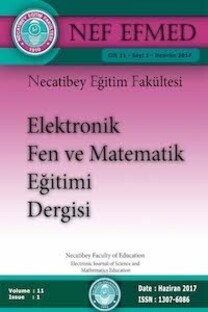Lisansüstü Öğrenciler “Çevre Kirliliği ve Elektromanyetik Kirlilik” Konusunda Yeterince Bilinçli mi?
çevre kirliliği, elektromanyetik kirlilik, lisansüstü öğrenciler
Are Graduate Students Sufficiently Aware of “Environmental and Electromagnetic Pollution”?
___
- Beyhun, N.E., Vaizoğlu S.A., Mete, A., Okur, S., Ongun, M., Orçan, S. & Güler, Ç. (2007). Hacettepe Üniversitesi Tıp Fakültesi 2005-2006 Öğretim Dönemi Son Sınıf Öğrencilerinde Çevresel Risk Algılama Düzeyi. TSK Koruyucu Hekimlik Bülteni, 6(5), 345-350.
- Birinci Konur, K. & Konur, B. İlköğretim Öğretmenlerinin Kullandıkları Ölçme Değerlendirme Metotlarına İlişkin Görüşleri. Necatibey Eğitim Fakültesi Elektronik Fen ve Matematik Eğitimi Dergisi, 5(2), 138-155.
- Boyes, E., Myers, G., Skamp, K., Stanisstreet, K. & Yeung, S. (2007). Air quality: a comparison of students’bconceptions and attitudes across the continents. Compare, 37 (4), 425–445.
- Çabuk, B. & Karacaoğlu, Ö.C. (2003). Üniversite öğrencilerinin çevre duyarlılıklarının incelenmesi. Ankara Üniversitesi Eğitim Bilimleri Fakültesi Dergisi, 36(1-2), 189-198.
- Kenar, I., Turgut, S. & Gokalp, M.S. (2013). Electromagnetic pollution awareness scale. International Journal of Educational Science, 5(3), 173-177.
- Lorenzini , G. & Nali, C. (2004). Bio-monitoring of ozone by young students. Journal of Biological Education, 38(4), 158-162.
- Maes, A., Collier, M., Vandoninck, S., Scarpa, P. & Verschaeve, L. (2000). Cytogenetic effects of 50 Hz magnetic fields of different magnetic flux densities. Bioelectromagnetics, 21(8), 589–596.
- Mortavazi, S.M.J., Ahmadi, J. & Shariati, M. (2007). Prevalence of subjective poor health symptoms associated with exposure to electromagnetic fields among university students. Bioelectromagnetics, 28, 326-330.
- Otto, M. & von Mühlendahl, K.E. (2007). Electromagnetic fields (emf): Do they play a role in children’s environmental health (ceh)?. Internatioanl Journal of Hygiene and Environmental Health 210, 635–644.
- Röösli, M., Moser, M., Baldinini, Y., Meier, M. & Braun-Fahrländer, C. (2004). Symptoms of ill health ascribed to electromagnetic field exposure – a questionnaire survey. International Journal of Hygiene and Environmental Health, 207, 141-150.
- Serway, R.A. & Beichner, R.J. (2009). Fen ve Mühendislik için Fizik 2, Elektrik ve Manyetizma – Işık ve Optik (K. Çolakoğlu, Çev. Ed.). Ankara: Palme. (2000).
- Sunay, Ç. (2000, Ocak). Teknolojiyle Gelen Sorun Elektromanyetik Kirlilik. Bilim ve Teknik, 386, 66-71.
- Tuncer , G., Sungur, S., Tekkaya, C. & Ertepinar , H. (2004). Environmental attitudes of the 6th grade students from rural and urban areas: a case study for Ankara. Hacettepe University Journal of Education, 26, 167-175.
- Tuncer, G., Tekkaya, C., Sungur, S., Çakıroğlu, J., Ertepınar, H. & Kaplowitz, M. (2009). Assessing pre-service teachers’ environmental literacy in Turkey as a mean to develop teacher education programs. International Journal of Educational Development, 29, 426–436 .
- Tuncer , G., Ertepinar , H., Tekkaya, C. & Sungur, S. (2005). Environmental attitudes of young people in Turkey: effects of school type and gender. Environmental Education Research, 11(2), 215-233.
- Tuncer , G., Sungur, S., Tekkaya, C. & Ertepinar, H. (2007). A Comparative Study on PreService Teachers' and Elementary Students' Attitudes towards the Environment. International Research in Geographical and Environmental Education, 16(2), 188-198.
- Valentina, S.E., Zizi, R.C., Elena, C., Violeta, A. & Anca, P. A. (2010). Electromagnetic Pollution of Environment. Latest Trends on Engineering Mechanics, Structures, Engineering Geology Full Textbook, 130-135.
- Yılmaz, A., Morgil, İ., Aktuğ, P. & Göbekli, İ. (2002). Ortaöğretim ve üniversite öğrencilerinin çevre, çevre kavramları ve sorunları konusundaki bilgileri ve öneriler. Hacettepe Üniversitesi Eğitim Fakültesi Dergisi, 22, 156-162.
- Yıldırım, A. & Şimşek, H. (2008). Sosyal Bilimlerde Nitel Araştırma Yöntemleri (6. Baskı). Seçkin Yayıncılık: Ankara, 94-228.
- Yılmaz-Tüzün, Ö., Teksöz Tuncer, G. & Aydemir, M. (2008). An investigation on the elementary teachers’ knowledge about air pollution issues. Hacettepe University Journal of Education, 35, 374-385
- WHO. (2005). Fact sheet 296. Electromagnetic fields and public health. Electromagnetic Hypersensitivity.
- ISSN: 1307-6086
- Yayın Aralığı: 2
- Başlangıç: 2007
- Yayıncı: Balıkesir Üniv. Necatibey Eğitim Fak.
Gökhan SONTAY, MURAT GÖKDERE, ERDOĞAN USTA
Ortaokul Seviyesinde Çevre Okuryazarlık Bileşenleri İle İlgili Ölçek Geliştirme Çalışması
Gökhan SONTAY, Murat GÖKDERE, Murat GÖKDERE, Erdoğan USTA
İşbirlikli Öğrenmenin Başarıya ve Tutuma Etkisi
The Effects of Cooperative Learning on Attitude and Achievement
Are Graduate Students Sufficiently Aware of "Environmental and Electromagnetic Pollution"?
Matematik Ders Kitabı İçeriklerinin Teknolojik Uygunluk Açısından Değerlendirilmesi: Ortaokul Örneği
